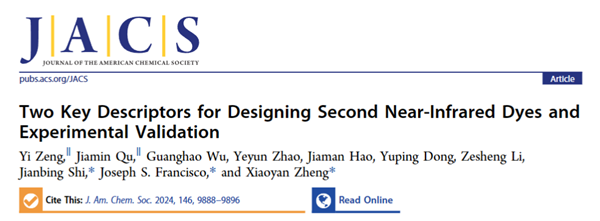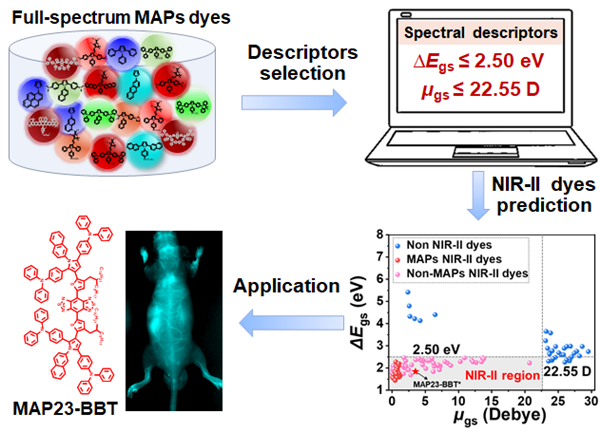

Updated: 2024-04-26

Significant progress has been made in the theoretical design of near-infrared II (NIR-II) fluorescent dyes by a team jointly led by Associate Professor Zheng Xiaoyan from the School of Chemistry and Chemical Engineering and Associate Professor Shi Jianbing from the School of Materials Science & Engineering, the Beijing Institute of Technology (BIT), in collaboration with Professor Francisco of the University of Pennsylvania. The related findings were published in the top international publication Journal of the American Chemical Society under the title "Two key descriptors for designing second near-infrared dyes and experimental validation." BIT is the primary affiliation, with doctoral students Zeng Yi and Qu Jiamin as co-first authors, and Associate Professors Zheng Xiaoyan, Shi Jianbing, and Professor Francisco as co-corresponding authors. Professors Li Zesheng and Dong Yuping provided critical guidance for this work.
Optical imaging technologies offer advantages like non-invasiveness, high sensitivity, and real-time monitoring, attracting growing attention in tumor diagnosis and treatment research. NIR-II (1000-1700 nm) fluorescent dyes are particularly notable for their deeper tissue penetration, lower tissue absorption and scattering, reduced autofluorescence interference, and higher spatial resolution, suggesting they could underpin personalized smart medical technologies. However, due to a lack of molecular design strategies and structure-property relationships, the development of new NIR-II dye structures has been slow. By utilizing theoretical calculations, researchers can establish the intrinsic relationships between molecular structures, key physical parameters, and spectra, which can enhance the efficiency of NIR-II dye molecular design and foster the development and application of new NIR-II dye molecules. Based on the study of assembly structures and luminescence mechanisms of fluorescent dyes (Aggregate, 2024, 5(1), e415; J. Am. Chem. Soc, 2023, 145(18), 10092; Proc. Natl. Acad. Sci. U.S.A., 2022, 119(12), e2116543119; by Angew. Chem. Int. Ed., 2022, 61, e202213615), Zheng Xiaoyan's team from the School of Chemistry and Chemical Engineering collaborated with Shi Jianbing's Aggregation-Induced Emission (AIE) research team from the School of Materials Science & Engineering. Using multi-aryl pyrroles (MAPs), which have potential applications in integrated diagnostics and therapy (Dyes Pigm., 2023, 219, 111569; Biomaterials, 2022, 283, 121409; Nanoscale, 2022, 14, 14064-14072; Sci. China Chem., 2021, 64(9), 1530-1539; Chem. Eur. J., 2020, 26, 14947-14953; Mater. Chem. Front., 2019, 3, 2072-2076), they designed 62 donor-acceptor (D-A) molecules with AIE characteristics as the original computational model. Through theoretical calculations of ground and excited state structures, as well as absorption and emission spectra, two key descriptors and their thresholds for characterizing NIR-II dyes were proposed: ΔE_gs ≤ 2.50 eV and μ_gs ≤ 22.55 D, where if both conditions are met, the molecule's emission spectrum can reach the NIR-II region.
To verify the accuracy of these descriptors, the absorption and emission spectra of 10 MAPs were experimentally tested, with results aligning precisely with theoretical predictions. Further, by calculating the spectra of 50 reported non-MAPs series NIR-II dye molecules, the universality of these two key descriptors was confirmed. Additionally, the NIR-II dye MAP23-BBT's application in bioimaging was evaluated, demonstrating significantly higher photostability and NIR-II emission intensity compared to the FDA-approved commercial dye ICG, achieving high spatial resolution in deep tissue vascular imaging. In summary, this work uses an interdisciplinary approach combining "AIE molecular design, quantitative calculation, characteristic descriptor screening, and experimental verification" to propose universal key descriptors for designing NIR-II dyes, providing an effective tool for the early assessment of new NIR-II fluorescent dye molecules.

Figure 1. The approach to predicting NIR-II fluorescent dyes and key results [Photo/english.bit.edu.cn]
This research was supported by the National Natural Science Foundation of China and the Beijing Natural Science Foundation.
Paper link:https://pubs.acs.org/doi/epdf/10.1021/jacs.3c14805
About the authors:
Zheng Xiaoyan is an associate professor and doctoral supervisor at the School of Chemistry and Chemical Engineering at BIT. Her research interests include theoretical and computational chemistry, with a focus on the luminescence mechanisms and assembly mechanisms of molecular aggregates, as well as the rational molecular design of biofluorescent probes. She has published over 90 papers in top international journals like PNAS, JACS, Angew. Chem. Int. Ed., and Nat. Commun., with an H-index of 32. She has been awarded several grants from the National Natural Science Foundation of China and the Beijing Natural Science Foundation.
Shi Jianbing is an associate professor at the School of Materials Science & Engineering at BIT. He has completed three projects funded by the National Natural Science Foundation of China and two from the Ministry of Education. He mainly focuses his research on the development of organic multifunctional materials and their applications, particularly in Aggregation-Induced Emission (AIE) materials and their biomedical applications, as well as synthesis methodologies for multifunctional polymers with applications in high-end photoresists and intelligent drug delivery. He has published over 100 papers in such journals as J. Am. Chem. Soc., Macromolecules, Biomaterials, and Sci. China Chem., with an H-index of 39, and holds seven authorized Chinese patents.














